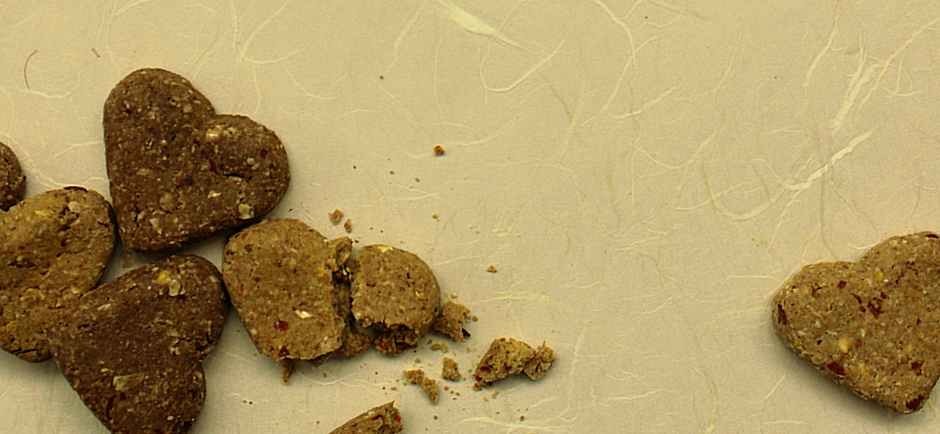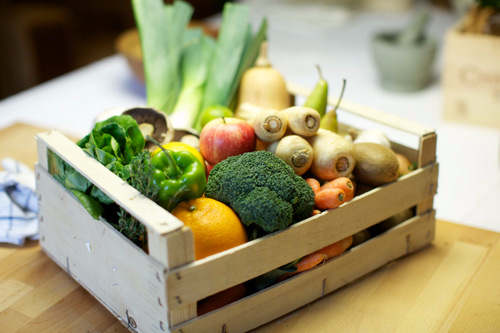

What Vegetables Can I Feed My Dog ?
Dogs have eaten vegetables the whole period of their evolution. They would consume digested and partially digested plant material in the stomach contents of their prey. Sometimes it was out of a need to survive when lean times were upon them or competition for food resources was a problem. A lot of our dogs still eat grass; possibly as a form of self-medicating as it is often regurgitated post-consumption along with frothy, yellow bile. Some, I think, just because they like it !
Do not confuse vegetables with cereals (carbohydrates) such as wheat and maize. From a physiological point of view, the digestive system of the domestic dog is not ideally designed for processing cereals. Animals that regularly eat cereals have a much longer digestive tract and start digestion in the mouth. Dogs’ digestive tract is short in comparison and they do not start to digest their food until it reaches the small intestine. A dog’s mouth is designed to break up and tear food apart. Heard the phrase “my dog inhales his food ? Well, now you know why. They don’t need to chew food like a cow chews the cud. Also, a dog’s saliva doesn’t contain Amylase, the enzyme required for the digestion of carbohydrates. The dog’s large intestine does produce pancreatic amylase but as this is where the last stage of digestion takes place, it seems to indicate that a dog’s diet should be low in carbohydrates.
Vegetable sources can provide much-needed fiber (both soluble and insoluble) and nutrients (vitamins, antioxidants, isothiocyanates, phytochemicals) and carbohydrates as part of a balanced diet. Sources suggest that a dog’s raw diet should contain 5-20% vegetable material. The quantity will depend on your dog and how well it can digest the food offered. A poo check (we all should do it !) will give an indication of digestive health and what your dog can or cannot digest. Also, as with people, increased intake or overdoing it on carbs, results in increased fermentation in the gut which must find a method of release i.e. a good fart ! Increased frequency of wind and any accompanying odours should be monitored.
Of your 5-20%, it should be 50% leafy greens. Leafy vegetables resemble the grasses eaten by prey. They are vitamin powerhouses, full of antioxidants and minerals. They possess cleaning and pH balancing properties while providing necessary fiber. Examples include carrot and beetroot tops, lettuces, dandelion leaves, coriander, basil, kale, and sprouted seeds. The remaining 50% should be sweet, unleafy or carbohydrate-rich vegetables.
When making a change to your dog’s diet, you may want to consult your vet first. You should also do it gradually. Try a selection of vegetables in small amounts over a couple of weeks, offering a spoonful at a time either on its own or combined with usual food. They should be given cooked or raw forms should be broken down with a hand blender or food processor. This is to help your dog digest the cellulose found in most vegetables. Furthermore, some raw vegetables have been said to interfere with thyroid hormone production in dogs. Blended is also preferable as it helps to predigest the food which is how wild dogs would find it in the stomachs of their prey. If your dog is hesitant to try the new offering, use it as reward for good behaviour.
Here are some veggie suggestions and their benefits:
ASPARAGUS
Source of vitamins A, B1, B2, C, E and K. Good for fiber and minerals such as folate, iron, copper, magnesium and potassium. May need to be given cooked due to its fibrous nature.
BEETROOT
Beetroot are a unique source of phytoneutrients called betalains. This have been shown to have antioxidant, anti-inflammatory and detoxification properties.
BROCCOLI
Loaded with nutrients such as Vitamin C, Beta Carotene, Folic Acid, Calcium and Chromium, the green trees we love to hate are a must-have. Broccoli also contains several important phytochemical, indoles and isothiocyanates and over 33 cancer preventative compounds.
BRUSSEL SPROUTS
Source of Vitamin C, K and A, folate, manganese and fiber.
CARROT
A bit of a super-food, there is some controversy over the feeding of carrots. Firstly, dogs appear to find them hard to digest when fed it in chunks or grated. A Poo Check would back this up either way. Secondly, there is the concern over the sugar levels in carrots. Despite this, carrots are a great source of Beta Carotene, a pro-vitamin A and a powerful antioxidant, which is nontoxic. Vitamin A can be toxic to dogs if fed in large quantities. Other Vitamins available include B, C, D, E and K and the minerals riboflavin, niacin, calcium, potassium, sodium and iron.
CELERY
The compound that gives celery its distinctive taste and smell has been found to significantly reduce tumours in laboratory animals. It is also said to reduce nervousness and neutralise acid. This may be why celery seed is suggested as a remedy for Gout in humans. Celery is rich in calcium, potassium, phosphorus, sodium and iron. Vitamins available are A, B and C.
EDAMAME BEANS
While providing iron, Vitamin K and B2, Omega-3 fats, phosphorous, potassium, copper and magnesium and fiber, they are also a good protein source. Shell first as the pod is very fibrous and difficult to digest.
GREEN BEANS
Contain Vitamin C, K and A, manganese and fiber
PARSLEY
Contains cancer-fighting phytochemicals and promotes fresh breath
PEAS
Fresh peas are available as snow, sugar snaps or shelled. Source of Vitamin K, C, A and B Vitamins, manganese, fiber, folate, phosphorous, magnesium, copper, iron, zinc and potassium. Also a source of protein.
PUMPKIN OR OTHER SQUASHES
If your dog needs to go on a diet or has a large appetite, cooked squash can make them feel full up. Feed 1 tablespoon per 10 pounds of bodyweight. Great source of beta carotene, Omega-3 oils, potassium and selenium.
RED PEPPERS
By weight, red peppers have 3 times as much Vitamin C as citrus fruits. They also contain beta carotene, like carrots, Vitamin B6 and fiber. They are also one of the few foods that contain lycopene, a phytochemical that may help prevent the various forms of cancers.
SPINACH
With twice as much iron as other greens, it is a rich source of antioxidants. It is a good source of fiber, calcium, potassium and vitamins A, B6 and K. Some research also suggests that if can discourage Chorophagia which is the technical term for a dog eating its own poo!!
SWEET POTATO
A good fiber provider, sweet potatoes are a good source of Vitamin A, C, B6 and B5, manganese, potassium and fiber.


